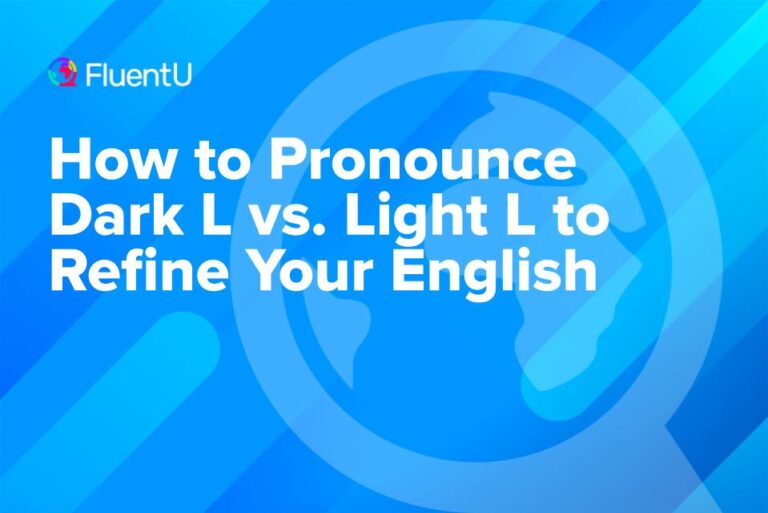How to Pronounce L in English and Level Up Your Speaking

Have you ever felt unsure about how to pronounce words like “hello,” “welcome,” and even “English” because of the letter L?
Then you’re not alone.
When it comes to consonant sounds, a lot of English learners have to pay extra attention to L, especially if it’s not part of their native language.
For example, languages such as Russian, Spanish, and Hindi have a different way of saying L. There are also languages where their L sounds closer to R instead.
In this guide, you’ll learn all about how to pronounce L in English, from example words and sentences to common mistakes to watch out for.
Let’s get started!
Download: This blog post is available as a convenient and portable PDF that you can take anywhere. Click here to get a copy. (Download)
Unpacking the L Sound
Here’s something about English pronunciation that can be confusing: one letter can have several possible sounds.
This includes the letter L, which is usually symbolized in the International Phonetic Alphabet as /l/. However, there are actually two types of L sounds in English: the light L and the dark L, depending on where L is in the word. Both of these also have different tongue positions when you pronounce them.
Depending on your native language, you might find it easier to say one type of L over the other. This can make your accent sound less natural, so it’s important to be able to use both L sounds smoothly.
How to Pronounce the Light L
Let’s dive into the first form of the L sound: the light L.
It’s the more standard pronunciation of L, and it’s usually what you’ll learn about right away. You’ll find the light L before a vowel sound.
To pronounce it, open your mouth a little, then bring the tip of your tongue up to either behind your front teeth or your alveolar ridge (the hard, bumpy part above your front teeth). The back of your tongue should be kept low.
That’s already the proper mouth and tongue position for light L! All you have to do then is to make a sound (since L is a voiced consonant). The sound is produced by air moving from the side of your tongue to the tip.
For practice, say “La la la” repeatedly.
Example Words:
- Lab
- Late
- List
- Letter
- Leader
- Please
- Online
- Weekly
- Class
- Display
How to Pronounce the Dark L
In contrast, the dark L is pronounced after a vowel sound.
Let’s take the word “tall.”
Right before the L, you form the vowel sound AW. When you shift from the vowel to the L sound, there’s a tense vibration in your throat, and the tip of your tongue starts to lift up and move forward while the back remains low in the mouth.
As you make the L sound, the back of your tongue curls up a little. The tip of your tongue can either touch behind your front teeth, as with the light L sound, or it can be suspended in your mouth without touching anything. You should feel more tension in your throat compared to the light L.
For practice, say “uhl” repeatedly.
Example Words:
- Control
- Crystal
- School
- Roll
- Well
- Digital
- Smile
- Milk
- Pool
- Trail
Common Mistakes in Pronouncing L
These three mistakes pop up the most frequently when English learners tackle the L sound:
1. Confusing R and L
Some English learners find it hard to feel the difference between R and L at first, especially if both of these sounds aren’t set apart in their native language. For example, L can sound like R in both Japanese and Mandarin.
When you’re working on your pronunciation, focus on how your mouth and tongue feel. With both L sounds, the tip of the tongue moves forward and up. However, if you’re pronouncing R, the tip of your tongue actually moves down as the back of your tongue curls up. You’re holding your tongue further back than with L, and your lips would also be more rounded.
2. Saying OH instead of L
In Portuguese, there are dialects that have their own version of dark L, which sounds more like OH. If you’re used to pronouncing it this way, you might instinctively carry it over to English at first, but this doesn’t work. For example, “tall” becomes more like “taw-oh” instead of “tawl.”
As with R and L, you’ll have to train your mouth to form the L sound in English instead. The OH sound’s mouth and tongue position is almost the opposite of the L sound’s. In OH, the tip of your tongue is lowered even as the back of the tongue is raised. Your mouth also comes close to forming a circle, while it’s neutral with L.
3. Making L barely audible
Another stumbling point is not putting enough strength into pronouncing the L sound, so it becomes way too light or hardly audible. When you’re making the L sound, your tongue is tensed up, and there’s air being pushed out around the sides of your tongue.
One way to solve this is by holding the L sound – you can start with the sound on its own and say “Llllll” for a few seconds while keeping your tongue in the same position. Once you can hold that, move on to pronouncing syllables: “La” for light L and “Uhl” for dark L.
Practice Sentences for the L Sound in English
Try reading these sentences slowly while keeping the L sounds in mind! If you’re not sure which type of L sound is in a word, you can look up the word in the examples above for light L and dark L.
- We’re heading to the lab.
- Can you buy milk on your way home?
- The meeting’s going to be online.
- History was her favorite subject in school.
- They’re tired because they went to a kickboxing class.
- This mountain trail works great for beginners.
- Who does he want to appoint as the leader?
- Hope you get well soon!
- Please sign in here with your name and company.
- It’s crowded at the pool today.
Conclusion
Pronouncing the L sound correctly in English is mainly about getting used to its two forms and learning the mouth and tongue positioning for both. Your native language has a major influence on which sounds you’re used to pronouncing, so check if it has the same L as in English. It’s possible too to already know the light L, for example, but the dark L feels completely new!
Either way, once you’ve mastered the L sound, you’re on your way to improving your pronunciation and speaking more neutral-sounding English. Words with L are very common, after all, so it’s a consonant sound that you’ll encounter again and again!







